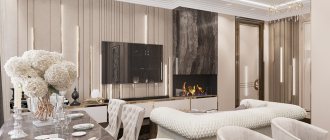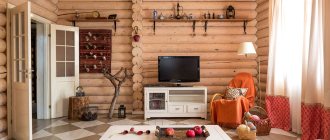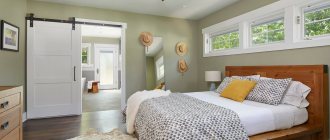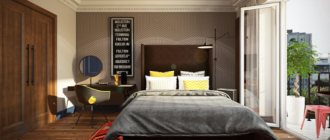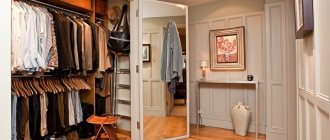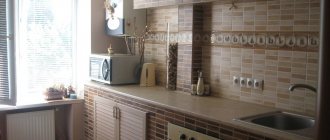So, you have decided to install an air conditioning system in your bedroom to maximize your comfort level and enjoy coolness or warmth while lying in bed. Surely, even at the installation stage, you will have the most important question: where is the best place to hang the air conditioner? Above the bed or opposite it? Is it necessary to use air conditioning in the bedroom at all or can you do without it?
In this article we will answer these questions in detail, and also tell you how to properly install an air conditioner in the bedroom, which place to choose and what nuances you should pay attention to so that the operation of a split system or all-in-one unit brings joy and not discomfort.
Wall options
A quiet air conditioner for a bedroom with a low noise level, no higher than 25 decibels - this is a set with separate units. The noise is mainly from the outdoor unit, while the indoor unit operates almost silently.
A great addition is the “Sleep” function. In this mode, the air conditioner itself regulates the temperature, automatically lowering or raising it, creating the most comfortable conditions for relaxation.
All air conditioners are equipped with an air purification filter, and some models are also equipped with a HEPA filter designed to get rid of dust mites. There are devices that allow you to control the level of humidity in a room.
What should the system be able to do?
Currently, manufacturers provide consumers with a large selection of air conditioners, but not all of them may be suitable for the bedroom.
To make your choice, you need to decide what the system should be able to do:
- Have a temperature control system with the smallest error (and adjustable using a remote control);
- Have an addition: a filter to clean the air from odors, dust, mites;
- Allows you to control the strength and direction of the air flow;
- Have a minimum noise level so as not to disturb sleep;
In addition, this household item should take up a small amount of space, be easy to operate, and have an additional heating option (for the cool season).
Floor units
Like any other technology, they have both advantages and disadvantages.
The obvious advantages include:
- Small dimensions;
- Mobility - if necessary, they can be easily moved to any place in the room;
- No need for special installation.
They are ideal for small spaces.
The disadvantages include an increased noise level (this is definitely not the quietest air conditioner for a bedroom), as well as the fact that the compressor heats up during operation, and accordingly the performance drops somewhat. And if the design does not have a container for collecting condensate, then you will have to provide it yourself.
There is another type of splits - columnar ones, but they are installed in large rooms; they are practically not in demand in everyday life.
Based on the above, we can conclude: the most convenient option for maintaining a comfortable temperature in the bedroom would be to install a wall-mounted air conditioner.
Besides running quietly and filtering air, it does not consume much electricity (especially inverter split systems). In addition, there are many options for the design of the indoor unit, so it is easier to fit them into the interior of the room.
Tip #4: Cool before bed
If you can't bear the cold wind while sleeping, you can still enjoy a cool bedroom. It's best to turn on the air conditioner about an hour before bed. The room can then cool down and the air conditioning can be turned off before bed.
Additionally, you can also use the timer feature. Set the air conditioner so that it turns off after a maximum of one hour. Because cool air especially helps when falling asleep. Once you fall asleep, your body temperature drops slightly on its own.
Installation location
To make the most of the capabilities of this type of equipment, you must adhere to several basic rules.
- It is necessary to install the split in such a way as to avoid air flow directed towards the sleeping place.
- The distance between the outdoor and indoor units should be as small as possible - this achieves maximum efficiency and energy saving.
- Inside, the block is installed so that its upper part is ten centimeters below the ceiling level.
It is a big mistake to install the unit above heating appliances, behind curtains or curtains. In the latter case, air circulation is simply disrupted, and constantly moving the curtains aside is not always convenient.
When choosing where to install an air conditioner in your bedroom, you have many options to consider. But it would be wiser to first study only the most common ones.
No. 1. Types of air conditioners
Air conditioners are different, and therefore the rules for their placement are different. Without going into details and features of choice, we will note only the main types of cooling devices that can be used in a home:
- mobile air conditioner - this is a small but quite heavy (30-50 kg) device, placed on the floor, can be easily moved around the room and apartment, it can even be transported to another house. A mandatory element of the design is a hose through which hot air is discharged to the street. As a rule, no questions arise regarding the installation of such an air conditioner. The main thing is that cold air does not blow on people, but if something happens, its direction can be easily corrected. The main disadvantage is a lot of noise;
- a window monoblock can only be installed in a window opening, as its name indicates. Such devices are not particularly effective, they take away light and spoil the appearance of the window, so they are rarely installed recently;
- split system – the most popular type of air conditioner today. Consists of two blocks, internal and external. The placement of the indoor unit, as a rule, raises the most questions, so we will pay maximum attention to this topic.
Above the bed
The natural desire to place the block above the bed is not always correct. Such a decision can only be determined by the fact that there is simply no other place.
If you still had to hang the block directly above the bed, you should provide some kind of screens designed to disperse air flows.
What influences the choice of location?
Choosing a place for the air conditioner
Everything, of course, depends on what design the air conditioner itself is, because there is window equipment, and there are also more modern split systems. If it’s a window, then you won’t have to rack your brains for long.
If there is a window air conditioner, then you need to decide which window - in the bedroom window, or maybe in the room? However, before you rack your brains about this, it is important to know that window air conditioners can only be installed on a window with a wooden frame. Such installation is not provided for metal-plastic windows.
However, if you really want to, you can also install it in metal plastic. Only for this you will have to order a new window, adapted for the future installation of a window air conditioner. Think about it, is it worth it?
Window air conditioner
It will also not work to embed it into the wall, since the window monoblock must “breathe” - be blown with air. But even if we assume that you managed to install the window miracle technology, over time you may regret it. The fact is that during operation the device makes a lot of noise. So your house will be cool, but noisy. A kind of microclimate that can be called “cool noise”. Therefore, we will choose a split system as a conditional situation.
Split system
So, you have become the proud owner of a modern class air conditioner. What does a split system consist of? Of 2 blocks: one external and the other internal. Installation begins with fixing the indoor unit and in a place where air flows will not hit you. Otherwise, you risk developing a sore throat or, best of all, pneumonia with all the ensuing complications. Everything must be carefully thought out and carried out in accordance with the recommendations outlined.
Above the door
This type of installation has its advantages and disadvantages. The indoor unit does not spoil the interior, since it is not visible when entering the room.
The disadvantages include the inconvenience that arises when installing communications: in this case, they are long and will have to be hidden either in a groove or under a decorative panel. And these are additional costs.
Place the indoor unit near a window
The reason is that it is easier to route the route from the indoor unit to the outdoor unit and you will not have to overpay for additional meters of wire installation. The farther from the window, the more expensive. In addition, if you do install an air conditioner after finishing, a box with hidden wires along the entire wall will definitely become something that will ruin the interior.
Photo: Instagram _marina_ky
- Technique
How to choose a split system: we understand the important characteristics and nuances
Across from the door
Such installation is possible provided that the presence of a split system does not affect the appearance of the room. The presence of tall furniture with relatively low ceilings may interfere with installation.
It is advisable that this wall be external; fewer problems will arise with communications.
What to look for when buying an air conditioner?
To make the right choice of split system, you need to understand:
- What area of the room should it be designed for?
- What additional features do you have?
- What noise level suits you?
- What level of energy consumption is suitable;
- What price will be “convenient” for you;
- Dimensions (which will fit into the place you choose);
- Box design.
Near the window
Installing the indoor unit above or near a window is an almost ideal solution. The external and internal blocks are separated only by a wall; therefore, the length of communications is short, and this increases work efficiency. True, you can’t hang thick curtains, and even if you have them, you’ll have to move them while the air conditioner is running.
Window air conditioners, although they are on their last days, are still in use. Installing them is not difficult, but they make a lot of noise, and their set of functions is rather weak.
Main functions of air conditioner 2021
In addition to an additional set of functions, modern models of the current year of production have a basic set:
- Timer;
- Ventilation;
- Self-cleaning;
- Remembering the latest settings;
- Fan speed adjustment;
- Night quiet mode;
- Remote control;
- Drying.
Above the TV
The TV in the bedroom is usually placed opposite the bed. A split installed above it is not a very good solution; cold air currents can fall on vacationers, and this is not always comfortable. Operating in air conditioning mode will not cause any damage to the equipment, but in heating mode it can contribute to additional heating of the equipment.
All details
Based on the calculation, certain data and wishes, the company develops an individual offer. Of course, without offering all the services: without painting or electrical work that may be necessary. Only then can you place an order for a new air conditioning system.
To sleep well, so that the body can recover properly at night, a good climate in the bedroom is necessary. Air conditioners are the best solution to combat changing weather conditions and help the user create an optimal climate for sleeping at night.
Above the cabinet
Sometimes in bedrooms you have to install the system above the furniture. This is very inconvenient, but if there are no options, the air conditioner should be mounted above the chest of drawers, and not above a tall cabinet.
And be sure to observe the following parameters: the distance between the surface of the furniture and the block should be about one hundred centimeters, with a distance between the split and the ceiling of at least ten centimeters.
How does air cool and heat happen?
During evaporation, the refrigerant is able to remove heat.
As a small experiment, you can do a little experiment. To do this, smear your hand with alcohol or a solution containing alcohol. After applying the liquid, you will feel cold on your hand, which is formed due to the evaporation of the liquid, thus, the alcohol, evaporating, takes away the heat emanating from the body. The reverse process: during condensation (that is, when a liquid passes from a gaseous state to a liquid), a substance releases thermal energy. This condensation process can be observed in a steam room. At the moment when the air conditioner operates in cooling mode, freon is subject to evaporation in the heat exchanger in the internal part of the system, and condensation takes place in the external block. When the device operates in heating mode, the entire process occurs in reverse order. Condensation occurs in the heat exchanger, and evaporation occurs in the outdoor unit.
How to use air conditioner correctly? To work with the equipment (to become familiar with the operating process and correctly turn on the system), it includes a user manual with a complete description of the operation of the modes and control of the system via the remote control.
Installation rules
When installing an air conditioner in any room, not just the bedroom, you need to choose the right equipment parameters. This takes into account the volume of the room and the degree to which it is loaded with furniture and decor in the form of carpets.
All other parameters can be found in the product data sheet. In the numerous photos of air conditioners in the bedroom, you can see a variety of installation options.
When installing an air conditioner, consider the height of the room. On average, the distance from the split to the ceiling is 7-10 cm, and in some cases even 15 centimeters. If the ceilings in the room are very high, above 3.7 meters, then the unit should be hung at a height of 3.2 meters from the floor, otherwise access to it for maintenance will be very difficult.
Air conditioners for apartments with two or more rooms
There are no special differences from previous recommendations in the selection and installation of air conditioners for two or three rooms.
Khrushchev buildings and their air conditioning
walk-through kopeck piece in Khrushchev
A standard two-room Khrushchev building can get by with one split into two adjacent rooms. The indoor unit is mounted above the doorway between the rooms in the passage hall. The air will be pushed off the opposite wall and flow into the bedroom. Typically its dimensions range from 8 to 11 m². It makes no sense to purchase an air conditioner for such a small room. A device with a power of 3.5-4.5 kW can easily cope with cooling and heating two adjacent rooms.
Owners of three rubles in a Khrushchev-era apartment with two adjacent rooms and one separate room can solve the problem of air conditioning without spending money on air conditioners for several rooms as follows:
- Adjacent (passage) rooms are decorated in the same way as described in the option for a two-room apartment;
- The problem of air conditioning the kitchen and the remaining small bedroom is solved by installing a more powerful unit next to the entrance door in the hallway. The downside is the long freon line across the entire room or kitchen.
Rulers and their conditioning
two-room line
If the apartment has a layout called “line”, then if you have a limited budget, there is absolutely no need to buy an air conditioner for two rooms, since the rooms are located here in one row. It turns out that the hallway is equidistant from them. This means that you can hang an inverter in it, which will provide cold and heat to all zones. This is acceptable if residents are willing to endure the arctic cold in the hallway, because to lower the temperature in the rooms and kitchen to 24°C, they will need to set it to 18°C.
Homeowners don't want to freeze in the hallway? Then the following recommendations regarding apartments with separate rooms will help.
Conditioned air saturation
Modern split systems have a fairly extensive selection of functions. One of them is the presence of an air ionizer.
- When it works, the air in the room is saturated with negative ions, which contributes to more comfortable breathing.
- In any air conditioner you can set the required air circulation mode. This can be a closed cycle, when air from the room, after cooling and filtering, is returned back into the room, or air can be taken directly from the street.
- Well, the winter-summer system allows you not only to cool the room, but also to heat it.
Installing a split system does not seem very difficult at first glance, but this point of view is somewhat wrong.
Installation of an outdoor unit often takes place at a height, and this already requires certain equipment and skills, so it is best to turn to professionals.
Cutting off heat flow from the window
cutoff of heat flow occurs with this arrangement.
This rule for placing an air conditioner in a room is especially relevant where the windows face the sunny side - to the south, southeast or southwest. The cooled flows blown out should go perpendicular to the sunlight and warm air entering the room. This will ensure that the set temperatures are reached as quickly as possible.
Photo of air conditioner in the bedroom
Requirements for installing air conditioners (split system)
Most air conditioners in use have a split system. This is an air conditioner design consisting of two parts: external and internal. They are connected to each other by copper pipes and electrical cable.
The external block consists of the following elements:
- at the base is a fan. It circulates air passing through the air heat exchanger;
- capacitor. In it, freon condenses and cools;
- compressor. It compresses the freon and pumps it into the refrigeration circuit;
- automation.
The indoor unit consists of:
- filter systems (coarse and fine cleaning);
- fan It circulates cooled air in the room;
- air heat exchanger cooling air;
- blinds. They regulate the direction of air flow.
In order for the installed air conditioner to live up to expectations, serve for a long time and not raise questions from the relevant authorities and neighbors, you need to adhere to three main points:
- Choose a high-quality air conditioner model. It should be powerful for the room, as quiet and compact as possible.
- Install the air conditioner correctly, choose the ideal location and check the quality of the fastening.
- Operate the structure in full compliance with the rules, regularly carry out preventive measures and monitor it.
Basic requirements for installing an air conditioner with a split system:
- the installation of the external unit is carried out on a solid basis;
- fastening of brackets to the wall is carried out using reliable mechanisms;
- a distance of at least 10 cm is maintained from the heat exchanger of the outdoor unit to the wall;
- a distance of at least 10 cm from the right modular block;
- a distance of at least 40 cm from the left modular block;
- there must be no obstacles within 70 cm in front of the block;
- free access to service ports is provided;
- interior items should not interfere with the free flow of air;
- the unit inside is installed further away from sources of moisture and heat;
- the indoor unit is not installed opposite the front door or window, which is constantly open;
- direct air flows should not be directed at people or places where they are often located;
- it is necessary to ensure high-quality removal of moisture through a drainage hose;
- the distance between the block and the ceiling is 15 cm minimum;
- The installation plate is fixed to the wall perfectly level using screws.
Let's take a closer look at the rules for installing an air conditioner, delving into the features of a split system.
Connecting blocks
In general, there are no special secrets here. We connect the communications stretched through the hole in the wall to the appropriate connectors. There are no problems with connecting the cable - you connect wires of the same color to the terminals that are already connected to them. In this case, you definitely can’t go wrong.
If the height difference in the installation of blocks exceeds 5 meters, it is necessary to make a loop to catch the oil (we lay copper pipes in this way) dissolved in freon. If the difference is lower, we do not make any loops.
Laying a route between the indoor and outdoor units of the split system
Drainage
There are two ways to drain drainage from a split system - into the sewer or just outside, outside the window. The second method is more common among us, although it is not very correct.
This is the drainage outlet of the indoor unit (at hand)
Connecting the drainage tube is also easy. A corrugated hose is easily pulled onto the outlet of the drainage system of the indoor unit (a tube with a plastic tip at the bottom of the unit). To keep it securely, you can tighten the connection with a clamp.
The same applies to drainage from the outdoor unit. Its exit is at the bottom. Often they leave everything as is, and the water just drips down, but it’s probably better to also put on a drainage hose and remove moisture from the walls.
Outdoor unit drainage
If you are using a polymer pipe rather than a hose, you will need to select an adapter that will allow you to connect the air conditioner outlet and the pipe. You will have to look on the spot, because situations are different.
When laying the drainage pipe, it is better to avoid sharp turns and certainly not allow sagging - condensation will accumulate in these places, which is not at all good. As has been said more than once, the tube is laid out with a slope. The optimal is 3 mm per 1 meter, the minimum is 1 mm per meter. Throughout its entire length it is fixed to the wall, at least every meter.
Freon circulation system
It is somewhat more difficult to connect copper pipes. They are laid out carefully on the walls, avoiding kinks and creases. For bending, it is better to use a pipe bender, but you can get by with a spring bender. In this case, sharp turns should also be avoided, but in order not to bend the tubes.
The ports on the outdoor unit look like this. Same on the inside
From the beginning we connect the tubes in the indoor unit. We unscrew the nuts from the ports on it. As the nuts are loosened, a hissing sound is heard. This is nitrogen coming out. This is normal - nitrogen was pumped in at the factory so that the insides do not oxidize. When the hissing stops, take out the plugs, remove the nut, put it on the tube, and then begin rolling.
Rolling
First, remove the plugs from the pipes and check the edge. It should be smooth, round, without burrs. If the cross-section becomes not round during cutting, use a calibrator. This is a small device that can be found in any store. It is inserted into the pipe, scrolled, leveling the cross-section.
The edges of the tubes are carefully aligned over a distance of 5 cm, after which the edges are flared so that they can be connected to the inlet/outlet of the blocks, creating a closed system. The correct execution of this part of the installation is very important, since the freon circulation system must be sealed. Then you will not need to refill the air conditioner soon.
Flaring copper pipes for air conditioner installation
When flaring, hold the pipe with the hole facing down. Again, so that copper particles do not get inside, but spill out onto the floor. It is clamped in the holder so that 2 mm sticks out. Exactly like that, no more, no less. We clamp the tube, install a flaring cone, and tighten it, applying considerable effort (the tube is thick-walled). Flaring is complete when the cone goes no further. We repeat the operation on the other side, then with the other tube.
This should be the result
If you haven’t rolled pipes before, it’s better to practice on unnecessary pieces. The edge should be smooth, with a clear continuous border.
Decoration
White conditioner has been a tradition for many years. Manufacturers continue to base their range on this color, but in the interior it becomes an obstacle. A simple and reliable option is decoration. Its use does not require professional skills, since a person chooses decor based on his own wishes. An interesting way was to use living indoor plants. Their branches and leaves are located on the top of the indoor unit, successfully hiding it. This is allowed by design, so the functionality is preserved.
Bright decor and simple techniques will make the air conditioner an attractive part of the interior. It will no longer be “conspicuous”, becoming just one of the details of the space. After which the room will turn into a whole picture, intriguing with its own beauty
Accordingly, a person will not have to give up comfortable coolness, so important on hot summer days

